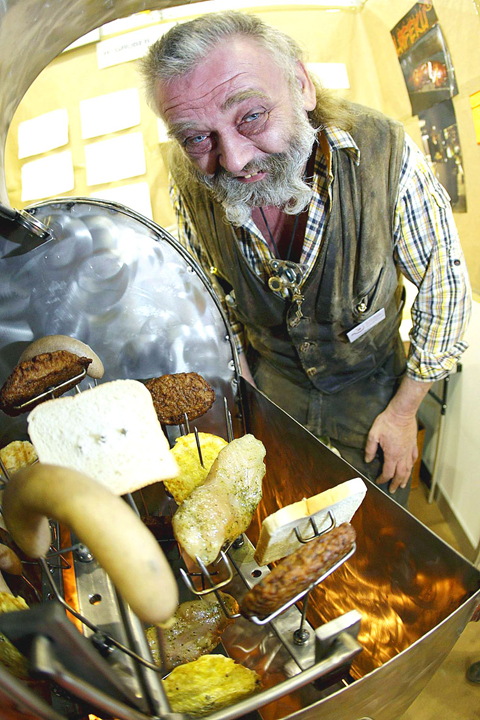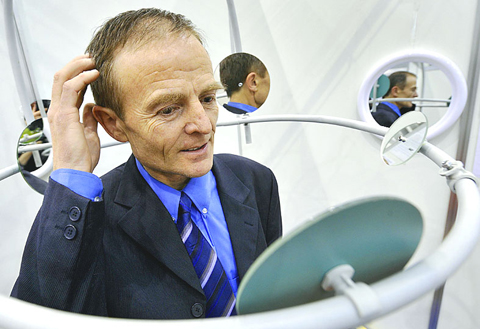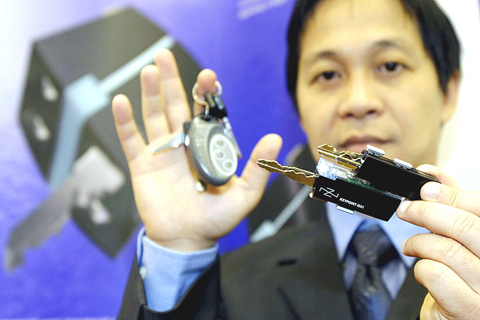A self-making bed and a non-smoking tobacco pipe were bound to make visitors take notice. Both inventions on display at the 36th International Exhibition of Inventions in Geneva were creative solutions to modern-day inconveniences or dilemmas.
Italian Enrico Berruti was getting a lot of attention as his so-called Selfy bed whirred into action behind him smoothing crumpled sheets as deftly as a hotel maid in three minutes.
"I am a little bit lazy and I hope that as I am lazy other people will be too," he said as two metal clips on runners tugged the bedding up the mattress on a frame that folds neatly out of the modern chunky wood bed.

PHOTO: EPA
The materials engineer, who normally works for an appliance-making firm in Calliano in Asti, added proudly: "It works on any kind of bedding including duvets." A more serious purpose, he insisted, would be to help people incapacitated by illness with the household chores.
His was one of 1,000 inventions on display from Asia, Arab countries and Europe at what organizers claim is the most important exhibition of its kind in the world. Inventors showing their products here until Sunday hope they will be picked up and become everyday essentials in life.
It was an eclectic mix. From Wales, a cat collar that unravels if the pet gets it snagged on something and a simple device to control fishing reel spools and eliminate fisherman's thumb burn.

PHOTO: AFP
More hard duty from Iran, students Houra Kasemi Nezad and Ali Naderi from the Azed Islamic University had developed a railway traverse from crystal concrete composite, guaranteed to last twice as long as existing steel reinforced concrete sleepers. While Mohamed Kalil Omran Eghfaier from Libya showed off his potentially lifesaving folding car. On impact the bonnet, on a kind of spring, squashes into the body to absorb the worst of the impact in a crash.
Students from the Technology University of Malaysia were exhibiting a number of products although still minus their luggage stuck at London Heathrow's chaotic Terminal Five.
Luckily they still had their invention with them, a flat compact antenna the size of a tea plate that fit into a waterproof box. "Important in the monsoon season" said Tharek Bin Rahman whose campus has become an official test site helping provide wi-fi technology free of cumbersome satellite dishes.

PHOTO: EPA
One of the students, Mohammed Adib, explained his Home Automatic Powerline Technology, HAPTech, which allows you to control your household appliances remotely from the comfort of your armchair or bed.
Among the 700 inventors from 45 different countries, were two Russians who had come up with the Freedom Pipe, an ingenious device to address the needs of smokers increasingly trapped in a non-smoking world.
Russian, Dim Khabibulin, who never touches a cigarette, said he and his fellow inventor, a chain-smoking 40-a-day man, had come up with the perfect compromise between smokers and non-smokers.
The very conventional looking pipe has an enclosed bowl and is fitted with a nicotine capsule. By heating the inhaled air and producing light and sound effects, it provides the sensation of smoking while in a smoke-free zone with none of the fumes or nicotine.
"It is the perfect compromise," smiled Khabibulin. The only problem would be convincing people the very realistic pipe was nothing but a battery operated look-alike.

On April 26, The Lancet published a letter from two doctors at Taichung-based China Medical University Hospital (CMUH) warning that “Taiwan’s Health Care System is on the Brink of Collapse.” The authors said that “Years of policy inaction and mismanagement of resources have led to the National Health Insurance system operating under unsustainable conditions.” The pushback was immediate. Errors in the paper were quickly identified and publicized, to discredit the authors (the hospital apologized). CNA reported that CMUH said the letter described Taiwan in 2021 as having 62 nurses per 10,000 people, when the correct number was 78 nurses per 10,000

As we live longer, our risk of cognitive impairment is increasing. How can we delay the onset of symptoms? Do we have to give up every indulgence or can small changes make a difference? We asked neurologists for tips on how to keep our brains healthy for life. TAKE CARE OF YOUR HEALTH “All of the sensible things that apply to bodily health apply to brain health,” says Suzanne O’Sullivan, a consultant in neurology at the National Hospital for Neurology and Neurosurgery in London, and the author of The Age of Diagnosis. “When you’re 20, you can get away with absolute

May 5 to May 11 What started out as friction between Taiwanese students at Taichung First High School and a Japanese head cook escalated dramatically over the first two weeks of May 1927. It began on April 30 when the cook’s wife knew that lotus starch used in that night’s dinner had rat feces in it, but failed to inform staff until the meal was already prepared. The students believed that her silence was intentional, and filed a complaint. The school’s Japanese administrators sided with the cook’s family, dismissing the students as troublemakers and clamping down on their freedoms — with

As Donald Trump’s executive order in March led to the shuttering of Voice of America (VOA) — the global broadcaster whose roots date back to the fight against Nazi propaganda — he quickly attracted support from figures not used to aligning themselves with any US administration. Trump had ordered the US Agency for Global Media, the federal agency that funds VOA and other groups promoting independent journalism overseas, to be “eliminated to the maximum extent consistent with applicable law.” The decision suddenly halted programming in 49 languages to more than 425 million people. In Moscow, Margarita Simonyan, the hardline editor-in-chief of the